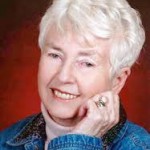As a child, Eve Bunting remembers spending cold, wet days in Northern Ireland, snuggling with her father in front of the turf fire while he read The Highwayman by Alfred Noyes and The Lady of Shalott by Lord Alfred Tennyson to her. She also remembers the many people who came to her home to borrow books. “My mother established a lending library in our house because she loved to read so much.”
Bunting not only loved to read, she loved to become the characters in her books. Anne of Green Gables by Lucy Maud Montgomery was one of her favorites. She asked her family to call her Anne and she pretended a nearby pond was the Lake of Shining Waters in Montgomery’s book. “I would leave a note for my parents that I was going to the Lake of Shining Waters. My mother said, ‘Oh, she’s only going to Murphy’s duck pond.’”
In spite of Bunting’s active childhood imagination and her love of writing in school, she never considered becoming a writer. “I came from a generation of girls that got married. . .It wasn’t until I was middle-aged that I began to think about writing at all.” She tested the waters with a Pasadena City College class, entitled “Writing for Publication,” and sold three stories to magazines. Quips Bunting, “After that, there was no stopping me!”
The author of more than 213 books, Bunting has explored a set of subjects as diverse as her adopted country, some of them never before found in children’s literature. Bunting blazed new trails, opening discussions about homelessness (Fly Away Home), the orphan trains that ran from New York to the mid-west from the 1850s to the 1920s (Train to Somewhere), the death of a parent (The Memory String), teenage pregnancy (Doll Baby), the Vietnam War Memorial (The Wall), the dangers of peer pressure and conformity (Riding the Tiger), Manzanar, the World War II Japanese internment camp (So Far From the Sea), and the 1992 Los Angeles riots (Smoky Night).
Bunting’s sense of adventure and play remains strong into her 70s. “I’m interested in everything. That’s why I write about so many different subjects.” Many of Bunting’s story ideas spring from newspaper articles or essays. Bunting describes the impetus for an idea as “something that touches me, something I see that strikes me as being awful, unfair, or that makes me laugh or cry. . .I don’t like to write anything that doesn’t mean a great deal to me.”
The picture book is Bunting’s favorite format. It’s short and succinct—the style of writing Bunting prefers. But it’s not easy. “Many people think I never have to revise or that the words magically flow out of me onto the page.” In fact, many of Bunting’s books require hours of research. For So Far From the Sea, Bunting visited Manzanar and bought all the books and tapes she could find. She read everything she could get her hands on regarding the Vietnam War Memorial for The Wall. For a book Bunting is currently writing, she wanted to make up one line of speech for George Washington. In order to create the correct atmosphere and capture a sense of the man himself, she read three or four books on Washington. After the research and first draft of each book, she revises diligently with her critique group that meets twice weekly. Once her editor accepts a new book, more revisions are necessary.
When Bunting isn’t on a research trip or speaking at conferences, she works from her Pasadena home. According to Bunting, “If I’m not writing, I’m thinking about writing.” She writes between three and four hours each morning—usually in long-hand with a pencil on a yellow legal pad. Although she tries to train herself to write at the computer screen, she says her stories don’t flow there; for Bunting, there’s a creative connection between her mind and the physical act of writing.
One of Bunting’s only books about her own experiences is Spying on Miss Müller. “There’s a lot of heart in that book,” she says. The main character, Jessie, is a thinly disguised Eve attending boarding school in Ireland during World War II. Generally, Bunting’s books tend to be more about other people. “I put my own beliefs into my books, my own hopes, something that will help make the world a better, kinder place. All these things are inside me or I wouldn’t put them in my books.”


